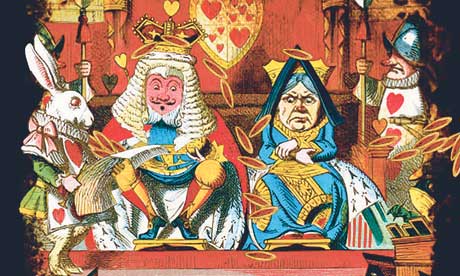 Guardian | Eager to find new ways to involve his readers in the mysteries of numbers, mathematician Marcus du Sautoy looked to new technology. A revolution is coming, he argues, and the whole idea of what a book can do is about to change.
Guardian | Eager to find new ways to involve his readers in the mysteries of numbers, mathematician Marcus du Sautoy looked to new technology. A revolution is coming, he argues, and the whole idea of what a book can do is about to change.Consider two books: Hilary Mantel's Wolf Hall and Lewis Carroll's Alice in Wonderland. Not the printed books, the apps – software for mobiles and the iPad. The Wolf Hall app is a thing of beauty. It contains the text, of course, but readers can also move slickly between the text, family trees of the Tudors and the Yorkists, extra articles by Mantel and a fascinating video discussion between the novelist and historian David Starkey. All of which gives a deeper and richer understanding of the novel's historical context and its characters.
But this is nothing compared to Alice for the iPad. You can throw tarts at the Queen of Hearts, help the Caterpillar smoke his hookah pipe, make Alice grow as big as a house and then shrink again. You can watch as "the Mad Hatter gets even madder", and throw pepper at the Duchess. Over the 52 pages of the app there are 20 animated scenes. Each illustration has been taken from the original book and has been made gravity-aware, responding to a shake, tilt or the touch of a finger. The story is never the same twice, because users are Alice's guide through Wonderland. The Caterpillar will smoke his hookah in a new way when you tilt your iPad, or you can throw more pepper the second time around.
It would have been quite simple to convert the printed files of Carroll's book and drop it straight on to the iBookstore, but what Atomic Antelope (atomicantelope.com) has done, through painstaking artistry, is to capture, for adults and children alike, the fantastical nature of the story. This is about recreating what a book is and can be. With the advent of new technology – devices such as the iPhone or iPad, the Sony Reader or the Kindle – authors and publishers are being offered a huge challenge: to reconceive their content to provide a visual and interactive experience that the printed book cannot provide. Art books with huge numbers of accessible images; architecture books with 3D plans of buildings; travel books with videos and interactive maps; children's books with games and characters who introduce themselves; and so on and on. The potential is vast. This is not a case of simply trying to cram written content on to an e-reader; this is about taking that content and completely reinventing it.
Currently readers are being offered little more than the novelty of a book on an electronic device, but the thrill of turning the page by clicking a button quickly pales. Many of the current projects are just tarted-up books for electronic media, but if it doesn't move the experience on to a new level, to enhance the material, what's the point? What authors and publishers need to do is to go back to the drawing board and, at the moment ideas are conceived, work out how – if at all – to make use of these new toys.


0 comments:
Post a Comment